Federal Judge Upholds Massachusetts Assault Weapons Ban
Another Federal Court loss for gun rights activists challenging state laws banning "assault weapons."
A Federal District Court Judge in Massachusetts has upheld that state’s ban on so-called “assault weapons,” handing yet another Court defeat to proponents of gun rights:
A federal judge dismissed a lawsuit on Friday challenging Massachusetts’s ban on assault weapons.
U.S. District Judge William Young said in his ruling that the firearms and large magazines banned by the state in 1998 are “not within the scope of the personal right to ‘bear Arms’ under the Second Amendment.”
The features of a military-style rifle are “designed and intended to be particularly suitable for combat rather than sporting applications,” Young wrote.
Massachusetts was within its rights since the ban passed directly through elected representatives, Young decided.
“Other states are equally free to leave them unregulated and available to their law-abiding citizens,” Young wrote. “These policy matters are simply not of constitutional moment. Americans are not afraid of bumptious, raucous, and robust debate about these matters. We call it democracy.”
The lawsuit was filed last year by the Gun Owners Action League of Massachusetts, who claimed the law infringed on their Second Amendment rights.
Attorney General Maura Healey (D), a defendant in the suit, said the ban “vindicates the right of the people of Massachusetts to protect themselves from these weapons of war.”
“Strong gun laws save lives, and we will not be intimidated by the gun lobby in our efforts to end the sale of assault weapons and protect our communities and schools,” Healey said in a Facebook statement. “Families across the nation should take heart in this victory.”
This ruling is just the latest example of a Federal Court rejecting a challenge to a state ban on “assault weapons” under the Second Amendment based on the Supreme Court’s ruling in D.C. v. Heller and McDonald v. Chicago. In those rulings, of course, which constitutes the Court’s first substantive look at the history, scope, and meaning of the Second Amendment in nearly a century and one of only a handful of such rulings in American history, the Court found that the Second Amendment protected an individual right and that, at the very least, this right included the right to own a handgun and keep it at home for self-defense. In McDonald, the Court extended that ruling to cover the states via the doctrine of incorporation as it has done with virtually the entire Bill of Rights. Since then, though, the nation’s highest court has not ruled on any significant challenge to Federal or state gun control laws and has instead allowed rulings from the lower courts upholding those laws to stand.
Specifically with respect to laws banning “assault weapons,” for example, no less than four separate Circuit Courts of Appeal have upheld challenges to state law bans on such weapons. The earliest such case came in 2011 in a case that has come to be called Heller II due to the fact that it involved essentially the same parties as in the Supreme Court’s 2005 ruling in District of Columbia v. Heller. In that case, the Court of Appeals for the D.C. Circuit upheld the District’s ban on “assault weapons,” finding that the ban did not impugn the right of self-defense on the right of self-defense recognized by the Supreme Court in the original Heller decision. Additionally, the Court held that the District had sufficient justification to believe that such weapons were too dangerous to be considered effective for self-defense and that such weapons posed “grave risks to bystanders and police officers. In early 2015, the Seventh Circuit Court of Appeals upheld a similar ban enacted by the City of Highland Park, Illinois. Several months later, the U.S. Court of Appeals for the 2nd Circuit reached the same conclusion in a case that challenged “assault weapons” bans enacted by New York and Connecticut that banned of “assault weapons” in the wake of the 2012 massacre at Sandy Hook Elementary School. Finally, and most recently, the Fourth Circuit Court of Appeals upheld a Maryland “assault weapons” ban in a ruling that was handed down just over a year ago.
As I’ve noted previously, the Supreme Court has declined to accept any of these cases for review.While the most we can say about this is that there were not four Justices who believed the Court should take up the cases for review, it does suggest that at least four now, the Justices are content to let these rulings upholding “assault weapons” bans across the nation stand. If nothing else, this sends a signal to Federal Judges in the lower courts that the Court is inclined to uphold those bans. Whether that signal is intentional or not, it is one that Federal Judges on both the District Courts and the Circuit Courts of Appeal are most likely taking to heart as this latest ruling demonstrates quite clearly.
In his opinion in this case, Judge William G. Young, a Reagan appointee who is now serving as a Senior Judge on the U.S. District Court of Appeals, made specific reference to the Supreme Court’s Heller decision and distinguished the Massachusetts law from the one at issue in Heller by specifically referencing Justice Scalia’s majority opinion. Essentially, Young found that the weapons impacted by the Massachusetts law did not fall within the scope of the type of weapons that Heller states were within the protection of the Second Amendment. In that opinion, Justice Scalia made clear that the Court’s ruling should not be construed to mean that every gun control measure violates the right protected by the Second Amendment:
Like most rights, the right secured by the Second Amendment is not unlimited. From Blackstone through the 19th-century cases, commentators and courts routinely explained that the right was not a right to keep and carry any weapon whatsoever in any manner whatsoever and for whatever purpose. See, e.g., Sheldon, in 5 Blume 346; Rawle 123; Pomeroy 152-153; Abbott 333. For example, the majority of the 19th-century courts to consider the question held that prohibitions on carrying concealed weapons were lawful under the Second Amendment or state analogues. See, e.g., State v. Chandler, 5 La. Ann., at 489-490; Nunn v. State, 1 Ga., at 251; see generally 2 Kent *340, n. 2; The American Students’ Blackstone 84, n. 11 (G. Chase ed. 1884). Although we do not undertake an exhaustive historical analysis today of the full scope of the Second Amendment, nothing in our opinion should be taken to cast doubt on longstanding prohibitions on the possession of firearms by felons and the mentally ill, or laws forbidding the carrying of firearms in sensitive places such as schools and government buildings, or laws imposing conditions and qualifications on the commercial sale of arms.We also recognize another important limitation on the right to keep and carry arms. Miller said, as we have explained, that the sorts of weapons protected were those “in common use at the time.” 307 U. S., at 179. We think that limitation is fairly supported by the historical tradition of prohibiting the carrying of “dangerous and unusual weapons.” See 4 Blackstone 148-149 (1769); 3 B. Wilson, Works of the Honourable James Wilson 79 (1804); J. Dunlap, The New-York Justice 8 (1815); C. Humphreys, A Compendium of the Common Law in Force in Kentucky 482 (1822); 1 W. Russell, A Treatise on Crimes and Indictable Misdemeanors 271-272 (1831); H. Stephen, Summary of the Criminal Law 48 (1840); E. Lewis, An Abridgment of the Criminal Law of the United States 64 (1847); F. Wharton, A Treatise on the Criminal Law of the United States 726 (1852). See also State v. Langford, 10 N. C. 381, 383-384 (1824); O’Neill v. State, 16 Ala. 65, 67 (1849); English v. State, 35 Tex. 473, 476 (1871); State v. Lanier, 71 N. C. 288, 289 (1874).
We also recognize another important limitation on the right to keep and carry arms. Miller said, as we have explained, that the sorts of weapons protected were those “in common use at the time.” 307 U. S., at 179. We think that limitation is fairly supported by the historical tradition of prohibiting the carrying of “dangerous and unusual weapons.” See 4 Blackstone 148-149 (1769); 3 B. Wilson, Works of the Honourable James Wilson 79 (1804); J. Dunlap, The New-York Justice 8 (1815); C. Humphreys, A Compendium of the Common Law in Force in Kentucky 482 (1822); 1 W. Russell, A Treatise on Crimes and Indictable Misdemeanors 271-272 (1831); H. Stephen, Summary of the Criminal Law 48 (1840); E. Lewis, An Abridgment of the Criminal Law of the United States 64 (1847); F. Wharton, A Treatise on the Criminal Law of the United States 726 (1852). See also State v. Langford, 10 N. C. 381, 383-384 (1824); O’Neill v. State, 16 Ala. 65, 67 (1849); English v. State, 35 Tex. 473, 476 (1871); State v. Lanier, 71 N. C. 288, 289 (1874).
The Miller decision that Scalia makes reference to here is United States v. Miller, a 1939 ruling from the Supreme Court upholding a law enacted in 1934 which placed restrictions on the ownership of the machine guns (i.e., fully automatic weapons) of the day and heavily taxed their owners. It’s clear that in this language, Scalia was intending to make it clear that Heller was not intended to overrule Miller and that it was also not intended to stand for the proposition that any regulation of weapons, including outright bans on the ownership and sale of certain types of weapons, was per se invalid under the Second Amendment. Based on that language, it seems clear that the argument that laws banning “assault weapons” are unconstitutional would face an uphill battle even in the conservative Supreme Court we have today and that the lower Federal Courts are likely to continue to uphold state and local, and if it ever came to pass Federal, laws banning such weapons in the future.
The next step for this case would be an appeal to the First Circuit Court of Appeals, which has yet to rule on similar laws in other states under its jurisdiction. That Court is currently evenly divided between Judges appointed by a Republican President and Judges appointed by a Democratic President. However, it’s hard to predict how any given First Circuit panel will rule in this matter. If history is any guide, though, it’s likely that the opponents of the Massachusetts law will have an uphill climb.
Here’s the opinion:
Worman Et Al v. Healey Et Al by Doug Mataconis on Scribd
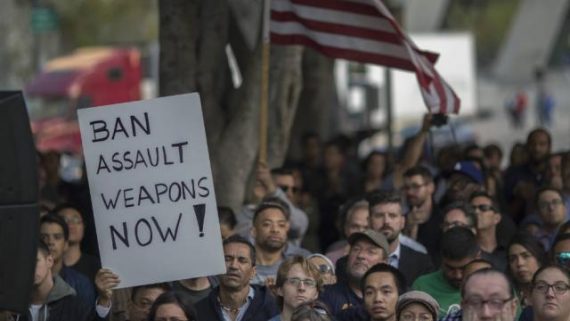

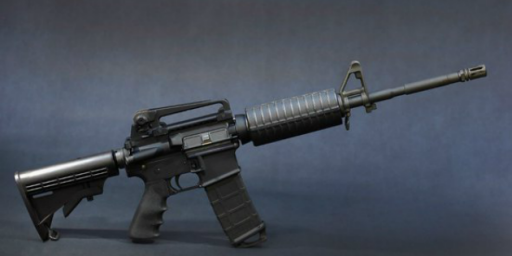
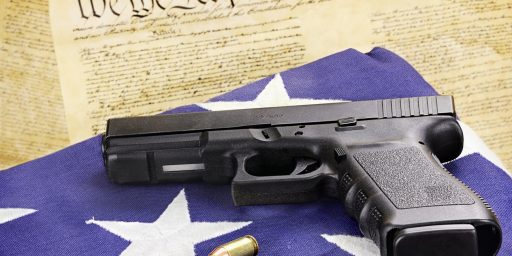

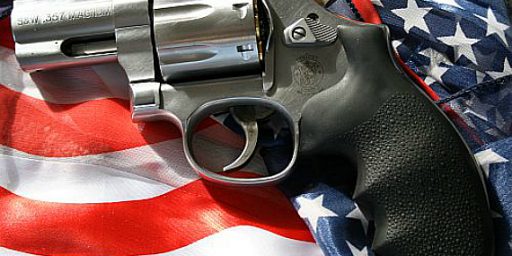
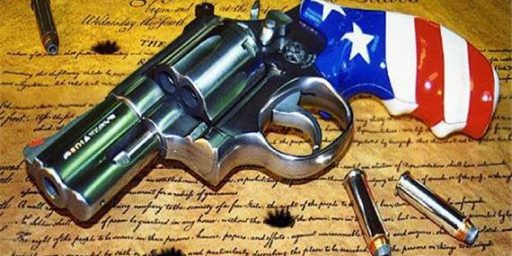
I find it very interesting, and not a little bit ironic, that Scalia’s Heller decision and opinion will probably be what allows regulation activists to most strongly make their case.
My suspicion is that in Heller. Scalia provided the most circumspect cover for gun rights.
@Sleeping Dog:
Scalia did in Heller what he was prone to do regardless: he picked an ideological position that he liked, crafted an opinion after the fact designed to protect that ideological position while attempting to limit subsequent ideological expansion. He failed in that regard, again as he was historically prone to do.